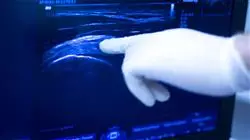University certificate
The world's largest faculty of nursing”
Introduction to the Program
With this Masters Degree, in 12 months you will be up to date with the latest studies and techniques used in clinical ultrasound"

Ultrasound scanners have improved in recent years allowing greater mobility and effectiveness, making it one of the most necessary tools for the healthcare professional. The versatility it offers in scans of different parts of the body has also made it appropriate for the nursing professional to have the relevant knowledge for its use. Likewise, time-sensitive situations such as emergency or intensive care require maximum safety and effectiveness in the detection of pathology.
In this context, the role of the nursing professional becomes more relevant, which in turn invites health care professionals to be constantly up to date with their knowledge in this field. This is why this Masters Degree in Clinical Ultrasound in Emergencies and Intensive Care for Nursing has been designed, where students can study in depth ultrasound imaging, echonavigation, as well as the technical requirements and methodologies used for the approach of patients with large syndromes or cardiac, musculoskeletal or abdominal problems.
Likewise, the case studies provided by the specialists who teach this degree will be very useful for nursing professionals in their daily clinical practice. In addition, detailed videos, interactive diagrams or essential readings will add dynamism and provide the up-to-date knowledge that students are looking for.
In this way, TECH offers the nurse an excellent opportunity to obtain the latest information in this field through a quality university degree that is compatible with the most demanding responsibilities. Students will only need a computer or tablet with which to access, at any time, the virtual campus where the syllabus of this Masters Degree is hosted. With no classroom attendance or fixed class schedules, students have the freedom to distribute the course load according to their needs.
Technological improvements have boosted the use of clinical ultrasound. Update your knowledge about it thanks to this Masters Degree"
This Masters Degree in Clinical Ultrasound in Emergencies and Intensive Care for Nursing contains the most complete and up-to-date scientific program on the market. The most important features include:
- The development of case studies presented by experts in Clinical Ultrasound
- The graphic, schematic, and practical contents with which they are created, provide scientific and practical information on the disciplines that are essential for professional practice
- Practical exercises where the self-assessment process can be carried out to improve learning
- Its special emphasis on innovative methodologies in Advanced Practice Nursing
- Theoretical lessons, questions to the expert, debate forums on controversial topics, and individual reflection assignments
- Content that is accessible from any fixed or portable device with an Internet connection
The specialized teaching team provides you with useful case studies for the examination of patients in Intensive Care"
The program’s teaching staff includes professionals from the sector who contribute their work experience to this training program, as well as renowned specialists from leading societies and prestigious universities.
The multimedia content, developed with the latest educational technology, will provide the professional with situated and contextual learning, i.e., a simulated environment that will provide immersive specialization programmed to learn in real situations.
This program is designed around Problem-Based Learning, whereby the professional must try to solve the different professional practice situations that arise throughout the program. For this purpose, the student will be assisted by an innovative interactive video system created by renowned and experienced experts.
With this program you will achieve the up to date knowledge you were looking for about the advantage of using ultrasound in paracentesis and stroke patients"

This Masters Degree provides you with the best didactic tools to keep you up to date with improvements in ultrasound and ultrasound imaging"
Why study at TECH?
TECH is the world’s largest online university. With an impressive catalog of more than 14,000 university programs available in 11 languages, it is positioned as a leader in employability, with a 99% job placement rate. In addition, it relies on an enormous faculty of more than 6,000 professors of the highest international renown.

Study at the world's largest online university and guarantee your professional success. The future starts at TECH”
The world’s best online university according to FORBES
The prestigious Forbes magazine, specialized in business and finance, has highlighted TECH as “the world's best online university” This is what they have recently stated in an article in their digital edition in which they echo the success story of this institution, “thanks to the academic offer it provides, the selection of its teaching staff, and an innovative learning method aimed at educating the professionals of the future”
A revolutionary study method, a cutting-edge faculty and a practical focus: the key to TECH's success.
The most complete study plans on the university scene
TECH offers the most complete study plans on the university scene, with syllabuses that cover fundamental concepts and, at the same time, the main scientific advances in their specific scientific areas. In addition, these programs are continuously being updated to guarantee students the academic vanguard and the most in-demand professional skills. In this way, the university's qualifications provide its graduates with a significant advantage to propel their careers to success.
TECH offers the most comprehensive and intensive study plans on the current university scene.
A world-class teaching staff
TECH's teaching staff is made up of more than 6,000 professors with the highest international recognition. Professors, researchers and top executives of multinational companies, including Isaiah Covington, performance coach of the Boston Celtics; Magda Romanska, principal investigator at Harvard MetaLAB; Ignacio Wistumba, chairman of the department of translational molecular pathology at MD Anderson Cancer Center; and D.W. Pine, creative director of TIME magazine, among others.
Internationally renowned experts, specialized in different branches of Health, Technology, Communication and Business, form part of the TECH faculty.
A unique learning method
TECH is the first university to use Relearning in all its programs. It is the best online learning methodology, accredited with international teaching quality certifications, provided by prestigious educational agencies. In addition, this disruptive educational model is complemented with the “Case Method”, thereby setting up a unique online teaching strategy. Innovative teaching resources are also implemented, including detailed videos, infographics and interactive summaries.
TECH combines Relearning and the Case Method in all its university programs to guarantee excellent theoretical and practical learning, studying whenever and wherever you want.
The world's largest online university
TECH is the world’s largest online university. We are the largest educational institution, with the best and widest online educational catalog, one hundred percent online and covering the vast majority of areas of knowledge. We offer a large selection of our own degrees and accredited online undergraduate and postgraduate degrees. In total, more than 14,000 university degrees, in eleven different languages, make us the largest educational largest in the world.
TECH has the world's most extensive catalog of academic and official programs, available in more than 11 languages.
Google Premier Partner
The American technology giant has awarded TECH the Google Google Premier Partner badge. This award, which is only available to 3% of the world's companies, highlights the efficient, flexible and tailored experience that this university provides to students. The recognition as a Google Premier Partner not only accredits the maximum rigor, performance and investment in TECH's digital infrastructures, but also places this university as one of the world's leading technology companies.
Google has positioned TECH in the top 3% of the world's most important technology companies by awarding it its Google Premier Partner badge.
The official online university of the NBA
TECH is the official online university of the NBA. Thanks to our agreement with the biggest league in basketball, we offer our students exclusive university programs, as well as a wide variety of educational resources focused on the business of the league and other areas of the sports industry. Each program is made up of a uniquely designed syllabus and features exceptional guest hosts: professionals with a distinguished sports background who will offer their expertise on the most relevant topics.
TECH has been selected by the NBA, the world's top basketball league, as its official online university.
The top-rated university by its students
Students have positioned TECH as the world's top-rated university on the main review websites, with a highest rating of 4.9 out of 5, obtained from more than 1,000 reviews. These results consolidate TECH as the benchmark university institution at an international level, reflecting the excellence and positive impact of its educational model.” reflecting the excellence and positive impact of its educational model.”
TECH is the world’s top-rated university by its students.
Leaders in employability
TECH has managed to become the leading university in employability. 99% of its students obtain jobs in the academic field they have studied, within one year of completing any of the university's programs. A similar number achieve immediate career enhancement. All this thanks to a study methodology that bases its effectiveness on the acquisition of practical skills, which are absolutely necessary for professional development.
99% of TECH graduates find a job within a year of completing their studies.
Master's Degree in Clinical Ultrasound for Emergency and Critical Care Nursing
The implementation of tools and technology in the medical field is fundamental to continue the development of the discipline. These instruments allow health professionals to perform their work with greater precision, effectiveness and guarantees for the patient. This is why equipment such as the transducer is used in the daily practice of medical personnel, which has allowed great advances in the processes of diagnosis and treatment through ultrasound. In that sense, at TECH Global University we designed the Master's Degree in Clinical Ultrasound for Emergency and Critical Care for Nursing.
Become an expert in the use of ultrasound instruments and techniques.
After completing the program, the Nursing professional will be able to perform skillfully in the use and implementation of clinical ultrasound as an extremely valuable diagnostic and treatment method for patients in situations requiring critical care. This is not only because of its dynamism, portability and accessibility, but also because it meets the conditions of quality care, ensuring safety, equity, timeliness and humanization of the patient, in addition to its effectiveness and efficiency. Through different modules, you will deepen the study of ultrasound and ultrasound imaging, as well as its use in different anatomical regions, such as cardiac, thoracic, vascular, cerebral, abdominal and musculoskeletal, among others.
Do a postgraduate course at the largest Medical School in the world
At TECH Global University we have the most complete and updated educational program in the educational market. Thanks to the use of different types of technology and an innovative learning method, students will be able to deepen their knowledge and develop new techniques that will have an impact on their professional career. Each student will have at their disposal a self-manageable program, since it adjusts to their daily needs and allows them to manage their schedules or study spaces.







